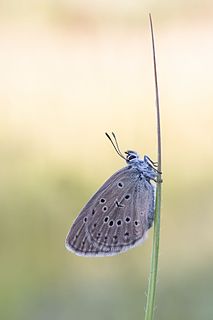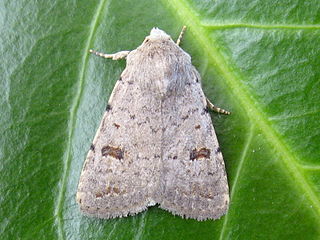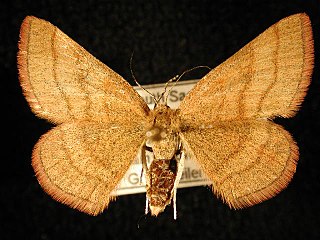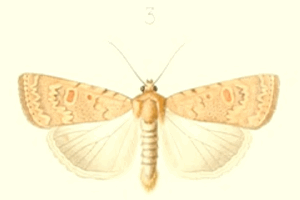
Phengaris rebeli, common name mountain Alcon blue, is a species of butterfly in the family Lycaenidae. It was first found and described in Styria, Austria, on Mount Hochschwab around 1700. Although it was initially classified as a subspecies of P. alcon, a European researcher, Lucien A. Berger, designated it as a separate species in 1946. Genetic similarities between P. rebeli and P. alcon have led many researchers to argue that the two are the same species and differences are due to intraspecific variation.

Caradrina morpheus, the mottled rustic, is a moth of the superfamily Noctuoidea. The species was first described by Johann Siegfried Hufnagel in 1766. It is found across the Palearctic from northern Europe to Siberia, Amur and Korea. Also in Armenia and Turkestan. It was accidentally introduced on both the east and west coasts of Canada and is so far reported in the east from New Brunswick to Ontario, and in the west from British Columbia.

Caradrina clavipalpis, the pale mottled willow, is a moth of the family Noctuidae. The species was first described by Giovanni Antonio Scopoli in his 1763 Entomologia Carniolica. It is found in the Palearctic realm. It is an introduced species in North America, where it was first reported from Queens in New York City in 1993. In 2009 it was found in Rochester, New York, so it appears to be established and spreading.

Caradrina kadenii, or Clancy's rustic, is a moth of the family Noctuidae. The species was first described by Christian Friedrich Freyer in 1836. It originates from southern and central Europe, Asia Minor and southern Russia but in the 21st century it has extended its range to the north.

Metasia is a genus of moths of the family Crambidae.
Aventiola is a monotypic moth genus of the family Erebidae described by Staudinger in 1892. Its only species, Aventiola pusilla, was first described by Arthur Gardiner Butler in 1879. It is found in Japan and south-eastern Siberia.

Caradrina is a genus of moths of the family Noctuidae. The genus was erected by Ferdinand Ochsenheimer in 1816. It is divided into eight subgenera, including Paradrina and Platyperigea, which are treated as separate genera by some authors.

Hypenodes is a genus of moths of the family Erebidae erected by Henry Doubleday in 1850.
Rhiza is a genus of moths of the family Noctuidae. The genus was described by Staudinger in 1889.
Stemmaphora is a monotypic moth genus of the family Noctuidae. Its only species, Stemmaphora viola, is found in Turkmenistan, Crimea and Uzbekistan. Both the genus and species were first described by Staudinger in 1888.

Gynaephora is a genus of "tussock moths", also known as the Lymantriinae, within the family Erebidae. They are mainly found in the Holarctic in alpine, Arctic and Subarctic regions, and are best known for their unusually long larval development period. The life-cycle of Gynaephora groenlandica was once believed to take fourteen years, but subsequent studies reduced it to seven, still a very slow development rate that is extremely rare in the Lepidoptera. The caterpillars have five instars, with each instar lasting a year.
Many types of polymorphism can be seen in the insect order Lepidoptera. Polymorphism is appearance of forms or "morphs" differing in colour and number of attributes within a single species. In Lepidoptera, polymorphism can be seen not only between individuals in a population, but also between the sexes as sexual dimorphism, between geographically separated populations in geographical polymorphism and also between generations flying at different seasons of the year. It also includes the phenomenon of mimicry when mimetic morphs fly alongside non-mimetic morphs in a population of a particular species. Polymorphism occurs both at specific level with heritable variation in the overall morphological design of individuals as well as in certain specific morphological or physiological traits within a species.

Caradrina multifera, the speckled rustic moth, is a moth of the family Noctuidae. The species was first described by Francis Walker in 1857. It is found in North America from Newfoundland to North Carolina and Tennessee and west to Minnesota and Manitoba. It is also present in British Columbia and Washington.

Scopula sentinaria is a moth of the family Geometridae. It is found from Alaska to Labrador, south in the prairies to southern Manitoba, Saskatchewan, Alberta and British Columbia. In the mountains it ranges south to Colorado. The species is also found in northern Russia and the Sayan Mountains. The habitat consists of dry shrubby clearings and edges.
Caradrina vicina is a moth of the family Noctuidae. It was described by Staudinger in 1870. It is found from Central and Southeastern Europe, eastern and central Anatolia, and Western to Central Asia. The habitat consists of grasslands.

Caradrina flava is a moth of the family Noctuidae. It was described by Charles Oberthür in 1876. It is found in Spain and Greece and on Malta and the Canary Islands, as well as from the Sahara to the Arabian Peninsula, Israel, Jordan, the Levant, Iran and Iraq.











